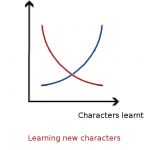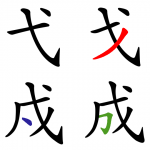Articles in the ‘Distinctively Chinese’ category Page 10
-
Learning to pronounce Mandarin with Pinyin, Zhuyin and IPA: Part 3
As adults, understanding is important when learning pronunciation. One way to achieve this is through the International Phonetic Alphabet (IPA), which will allow you to see the sounds your ears might fail to hear. Learning IPA also means learning basic phonetics, and that will do you good in the long run!
Read → -
The real challenge with learning Chinese characters
The real challenge when learning Chinese characters is not to commit a large number of them to memory, it’s to relate them to each other, including how they are used, how they are different and how they are similar. Creating such an interconnected web is a lifelong project.
Read → -
Can native speakers be wrong about Chinese grammar and pronunciation?
What does it mean when something is said to be “correct” in Chinese? Who’s right if all the people around you say something, but the dictionary says something else? Mandarin is a huge language spoken my a very large number of people, so some variation is to be expected. This article is about the flexibility of Mandarin and how to deal with it as a student.
Read → -
Learning Chinese characters through pictures
This article is about using pictures to learn Chinese characters. In order to learn characters efficiently, it’s important to understand how they work and what the building blocks are so that these can be used in other characters. Any pictures you use to remember should be based on this. Avoid using pictures that obscure the real meaning.
Read → -
Panning: How to keep similar Chinese characters and words separate
The real challenge when learning Chinese characters and words isn’t to remember them, it’s to keep them separate from each other. This article concludes my series about zooming and panning to integrate your knowledge better.
Read → -
Zooming out: The resources you need to put Chinese in context
In order to learn efficiently, it’s important that you integrate your knowledge. This means being able to break down Chinese in order to understand it, as well as looking at context and sorting out confusing cases. In this second article, I introduce tools for zooming out and putting things in context.
Read → -
Zooming in: The tools you need to break down and understand Chinese
In order to learn efficiently, it’s important that you integrate your knowledge. This means being able to break down Chinese in order to understand it, but it also means looking at context and sorting out confusing cases. In this first article, I introduce tools for breaking Chinese down.
Read → -
Chinese listening practice with 锵锵三人行
锵锵三人行 is one of the few Chinese TV programs I actually like. It’s also one of the best ones for language learners too, mostly because of it’s heavy focus on talking, availability of transcripts and variety of both guests and topics. This should be a key component of any immersion effort, but you probably need to be upper intermediate or above to benefit.
Read → -
What you intend to write is more important than the character you actually write
Why is focusing on intent important when learning to write Chinese characters? What you intend to write is more important than what you actually write.
Read → -
24 great resources for improving your Mandarin pronunciation
In this article, I list 24 great resources for learning pronunciation. Naturally, some of them are limited to Mandarin Chinese, but many are more general in nature and works for other Chinese dialects or even other languages. Resources are sorted into Basic sound references, Pronunciation explained, Advice on learning pronunciation and Useful software and applications.
Read →









